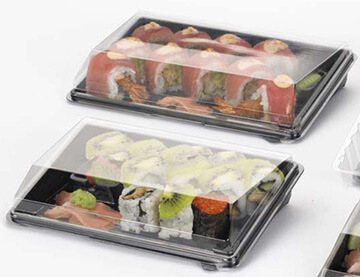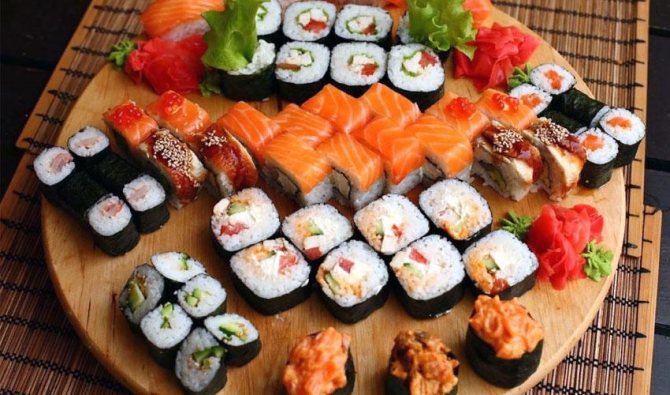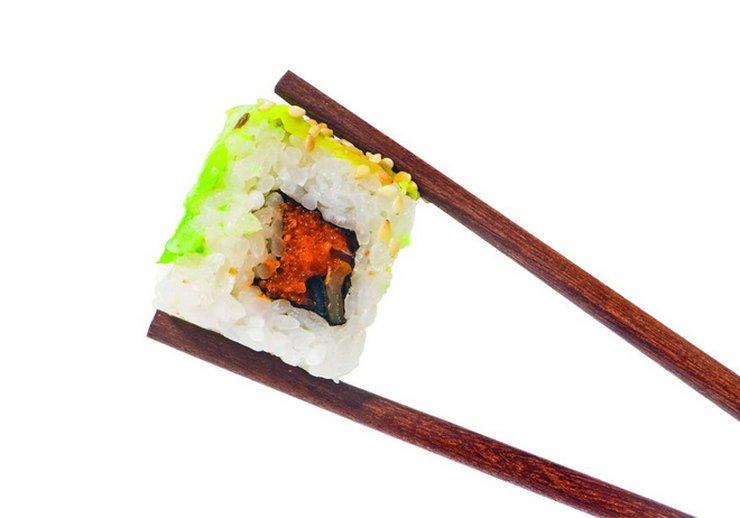What is regulated
- TU 9266-020-10926000-08 “Culinary products of Japanese cuisine - sushi, rolls” establishes production and technological regulations.
- MUK 4.2.1847 “Sanitary and epidemiological assessment of the justification of expiration dates” regulates the time and procedure for storage.
- SanPin 2.3.2.1324-03 “Hygienic requirements for shelf life, storage conditions” lists the procedure for reliable protection, nutritional importance at all stages of production and delivery.
- SP 2.3.6.1079-01 “Sanitary and epidemiological requirements for public catering organizations, production, circulation of food products, food raw materials” contains conditions at all stages.
- SanPiN 2.3.2.1078-01 “Hygienic requirements for safety and nutritional value” establishes requirements for compliance with these standards.
- TR CU 021/2011 “On the safety of food products” regulates production, storage, transportation, sales, and disposal.
- TU 9161-101-38826547-2015 “Japanese snacks (sushi, rolls)” controls retail trade and delivery to the end consumer upon order.
The benefits of Japanese cuisine
To prepare most dishes in Japanese cuisine, seafood and fish , which are rich in phosphorus, calcium and fatty acids.
Fish and rice are an excellent combination for good digestion. The ingredients complement each other perfectly and are dietary.- Nori seaweed sheets, which are part of the Asian dish, are rich in iodine, iron and calcium.
- Ginger is an excellent antiviral agent; it boosts immunity and fights colds.
- Wasabi improves blood circulation and absorbs antioxidants.
Timing and types
To diversify oriental cuisine, vegetables and fruits are used instead of fish. The shelf life of the dish depends on the shelf life of the ingredients.
| Kinds Dear readers! To solve your problem right now, get a free consultation — contact the lawyer on duty in the online chat on the right or call: +7 (499) 938 6124 — Moscow and region. | Deadlines (hours) | |||
| In a refrigerator | Without refrigerator | Chilled (from 2 to 6°C) | Frozen (above -10°C) | |
| With fish | 24 | 3 | 18 | — |
| Vegetarian | 30 | 3 | 18 | — |
| With fruits | 48 | 3 | 18 | — |
| Baked | — | By preparation | — | — |
If the fish is raw, it is advisable to consume the finished dish within three hours. Salted or smoked - stored for a short time in a cool place.
The refrigerator is used to store rolls with vegetables for 2 days. They will not spoil, but their taste will lose their exoticism.
When filling with fruit, food can be left in a cool place. It is suitable for use for 30 hours.
Baked rolls with filling are eaten immediately after cooking. They are not stored.
Important: rolls cannot be frozen!
Place of preparation
In order not to lose its taste, it is customary to prepare the delicacy immediately before eating. Catering establishments try to adhere to this rule, prepare after the order is accepted, and serve as it is completed.
Homemade ones can be eaten completely fresh. If the dish is made with a reserve, it should be stored airtightly packaged in a refrigerator at a temperature of 2...3 ° C. The presence of raw fish indicates a momentary meal; such sushi cannot be left for tomorrow.
Store-bought products must be eaten no later than the day of purchase. The marking, which indicates the date, hour and minutes of manufacture, must be examined. You need to buy the amount that you can eat at one time. There is no need to purchase ready-made goods stuffed with raw fish - they will spoil in an hour.
Store
Modern shopping centers where Japanese dishes are sold are equipped with refrigerated display cases. This treatment prevents rice, fish, and other ingredients from drying out, but it does not lengthen the time of use. When purchasing in a store or ordering online, when delivery by courier is implied, in addition to studying the labeling, you need to evaluate the product visually.
In the absence of readiness details, the question arises of exactly how long the goods have been lying around. It may be stale and it is not recommended to buy it. High-quality sushi is consumed within 3 hours.
Important: the marking must contain the date, month, year and exact time of manufacture.
Homemade
At home, you need to eat prepared sushi as it appears. Only fresh ingredients are used, which are boiled and cut as needed. If you plan to serve guests and the dish is prepared in advance, the time in the refrigerator ends after 3 hours.
During this period, the products are hermetically packaged and cut into portions before serving. Rolls must be stored without fish and fish products.
What is it made of?
Sushi originally emerged as a way to preserve fish, but today it is a perishable product. They practically do not use shelf-stable products, with the exception of rice and sauces.
The dish is based on rice and fish, two staples on the Japanese menu. However, it was not the Japanese who invented sushi, but their continental neighbors from South Asia.
The salted fish was placed between layers of cooked rice for storage and transportation. It was only in the 15th century that fish began to be consumed together with rice “coat”.
And at the beginning of the 20th century, with the light hand of one Japanese experimental chef, sushi began to be prepared with raw fish.
Sushi is a piece of fish on a ball of rice. Note that rolls are the type of sushi that is most widespread in the Western world. To prepare sushi, only rice, fish and seafood are used, and rolls can be filled with any filling along with fish. Rolls can be meat or vegetarian, even fruit.
When preparing these dishes, the main thing is not to forget the basic postulate - only selected ingredients should be used. And the cook needs to preserve their beneficial properties and taste. Accordingly, no “second freshness” in products is allowed in this case.
Storage

The product storage time begins to count down:
- from the moment of preparation - at home;
- from the moment of serving - in the restaurant;
- from the moment of receipt – upon delivery;
- according to the labeling - when purchasing ready-made ones.
It is necessary to take into account the permissible temperature, the quality of packaging, the ingredients of the products, and the place of preparation.
Important: if you neglect the storage rules, you can not only end up with a dish of unsatisfactory taste, but also get poisoned.
Where to store
It is recommended to store rolls or sushi for 2-3 hours in the refrigerator, provided that there is no mayonnaise or fresh fish in their composition. If the fillings are smoked or have a long shelf life, or are prepared at home, the shelf life can be extended.
The freezer is not intended for storage. After defrosting, rice becomes a watery porridge, and any filling spreads, irrevocably losing its taste.
A cool place keeps the rolls for 3 hours. At the same time, the taste quality deteriorates after the first hour. Long-term storage leads to souring and the sushi becomes unsuitable for consumption.
You can leave the dish at room temperature for a short time, from 1 to 3 hours.
What to store in
When cooking at home, the ideal option is a flat porcelain plate, tightly wrapped in cling film or parchment paper.
When purchased or delivered, rolls or sushi may be in a plastic container with a lid. This type of packaging is used for transportation; it does not ensure safety, and if exposed to air, it deteriorates faster. It is necessary to transfer the contents from the container and pack it.
Polymer trays with film are airtight containers. If it is not opened, you can leave the food packaged.
Before eating, you need to warm up the dish a little using a microwave oven, this will improve its taste.
How to understand that a product is spoiled
Must be freshly prepared and consist of high-quality raw materials. To understand this, it is worth assessing its appearance.
Fresh fish has a uniform bright color and a characteristic oily sheen. A dull, faded appearance, dark spots indicate an unsuitable product. A strong fishy smell is an indicator of spoiled raw materials. Sushi should smell a little like iodine.
High-quality rice – white, soft. If it starts to crumble, it means it's not fresh. Nori should also be soft - it absorbs moisture.
What happens if you store sushi incorrectly?
If you store them for too long, the rice, which is almost always present in the composition, will turn sour, or the filling will spoil. Due to the fact that perishable components are used for the latter without heat treatment, a pathogenic environment develops in the filling during long-term storage - not only various types of bacteria, but also toxins.

If stored improperly, sushi can pose a health hazard.
Even when eating raw fish, there is always a risk of becoming infected with helminths . This happens mainly when cooking with your own hands.

Fish often contain parasites
Because of all these points, Japanese cuisine is considered perishable and unsuitable for long-term storage.
Video - About the shelf life of different products
What are the signs that indicate that a dish has gone bad?
This can be understood by the aroma, appearance and changed taste. So, rolls should always have only a slight odor of iodine. If there is a characteristic aroma of fish or rotting, then we can confidently say that the dish has gone rotten. In addition, any unusual smell that signals spoilage should be a reason to be wary.
If the rice is dry and falls out, this indicates that the rolls were prepared long ago, which means they could have gone bad. The same is evidenced by dried nori seaweed.

The degree of freshness can be determined by smell and appearance
On a note! A fresh dish usually melts in your mouth. And if the filling has hardened, it means the sushi is stale and can harm your health!
Is it possible to use expired
After the expiration date, sushi and rolls deteriorate irreversibly. The danger of use may be:
- food poisoning;
- helminth infection;
- infection with staphylococcus.
The food is not subject to heat treatment (except baked), the ingredients are raw materials. All this contributes to rapid rotting and souring. Raw salmon may contain parasite larvae, which quickly progress if the preparation and preservation regime is not followed.
You need to be careful when purchasing finished goods. The price differs significantly from the cost. To make a profit, unscrupulous entrepreneurs violate the conditions of maintenance and sale. You need to be attentive to the labeling and appearance of the products offered.
Dear readers! To solve your problem right now, get a free consultation
— contact the lawyer on duty in the online chat on the right or call: +7 (499) 938 6124 — Moscow and region.
+7 (812) 425 6761 — St. Petersburg and region. 8 (800) 350 8362 - Other regions of the Russian Federation You will not need to waste your time and nerves - an experienced lawyer will solve all your problems! Or describe the situation in the form below:
Is it possible to freeze rolls?
Rice in the right packaging tolerates freezing tolerably; the shelf life in the freezer reaches three months. The same rule applies to cheese and eggs. But cucumber, avocado, and other fresh vegetables and herbs spoil incredibly after thawing. Fish and seafood are supplied to production frozen. Sent to the cell again - there is a risk of poisoning and loss of taste. Valuable ingredients are lost.
The second point is nori sheets. When any ingredients thaw, juices come out, the algae becomes limp, and the products lose their shape. They color the rice, fall apart, spoil the taste and overall impression.
You cannot freeze rolls, regardless of the type of filling. This method cannot increase the shelf life.











